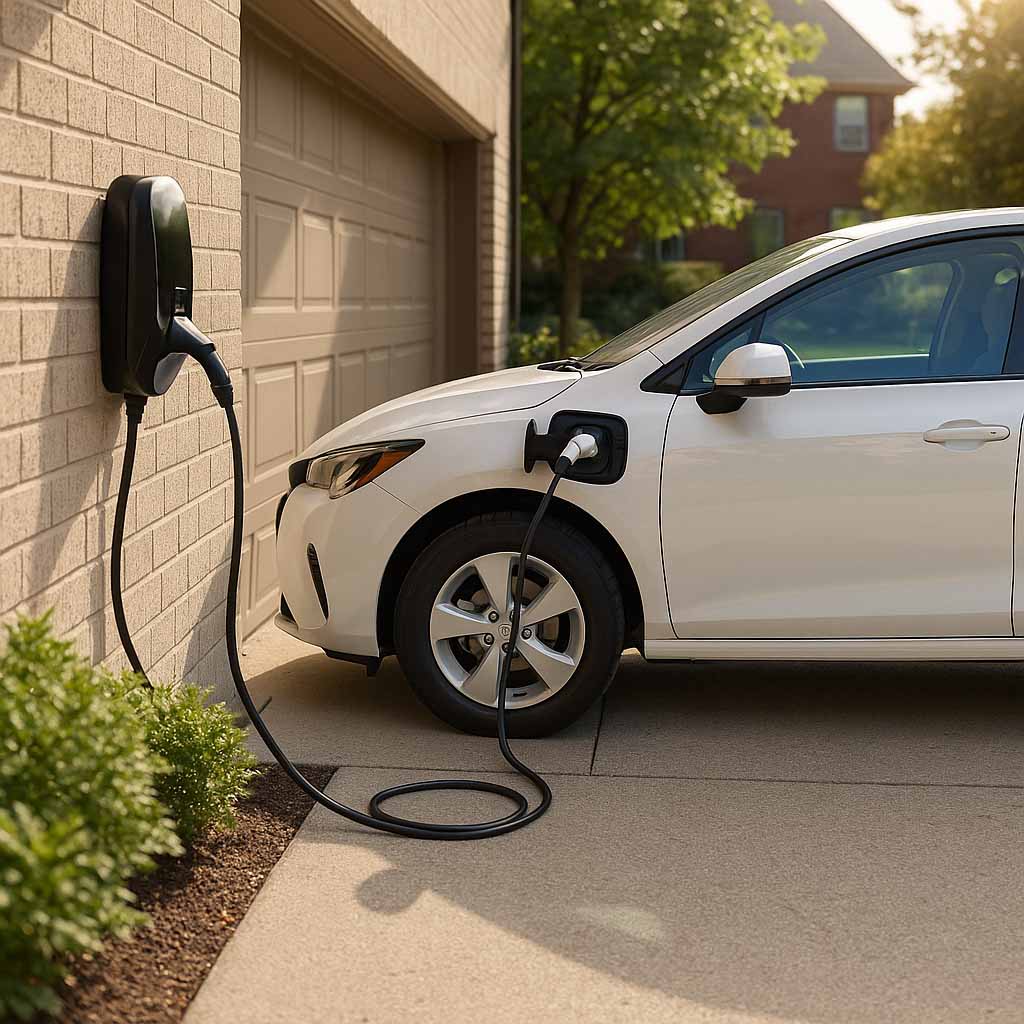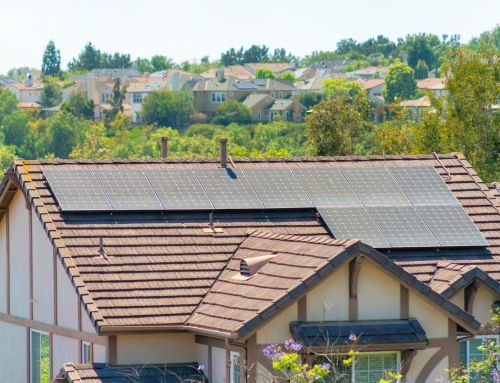Are you tired of rising electricity bills from charging your electric vehicle? Looking for a cleaner, more sustainable way to power your car instead of relying on fossil fuels? Solar EV charging may be the solution. More homeowners in Central Florida are embracing electric cars, but while these vehicles need electricity to run—just like your phone needs charging—most electricity still comes from power plants that burn natural gas and increase your carbon footprint.
By harnessing solar energy, you can charge your EV at home with clean, renewable power. This reduces greenhouse gas emissions, lowers your utility bills, and supports a more sustainable lifestyle. In this guide, we’ll explore how residential solar makes solar EV charging possible, why it benefits both your energy consumption and the environment, and how installing solar panels can help you achieve true energy independence.
How Solar Panels Work for Car Charging
Solar panels turn sunlight into electricity through something called the photovoltaic effect. Don’t worry – it’s simpler than it sounds! When sunlight hits the panels on your roof, it knocks electrons loose in the silicon cells. These moving electrons create direct current (DC) electricity measured in watts.
The electricity from solar panels is direct current, but your home and charging station need alternating current (AC). A solar inverter changes the DC electricity to AC electricity. This makes it usable for your car charger, water heating systems, heat pumps, and other home infrastructure.
In sunny places like Central Florida, solar panels work great because there’s abundant sunlight year-round. With enough solar power infrastructure on your property, you can generate plenty of renewable energy to power both your home and electric car. The technology for home solar has improved dramatically, making it more efficient and affordable.
You can also add energy storage systems like the Tesla Powerwall to store extra energy. This means you can charge your fleet of vehicles (whether you have an electric car or hybrid vehicle like the Hyundai IONIQ) at night during a power outage when the sun isn’t shining. This backup system ensures you’re never without power for your telecommunications devices or other critical needs.
How Solar-Powered Car Charging Works
The whole energy system works together like this:
- Solar panels on your roof capture sunlight and generate electricity
- The solar inverter changes this electricity from direct current to alternating current power
- This power flows to your home and electric vehicle charging station
- Any excess electricity gets stored in batteries for later use or sent back to the grid through net metering
Your charging station (sometimes called an EVSE – Electric Vehicle Supply Equipment) handles the flow of electricity safely to your vehicle. Many modern charging stations are “smart” – they can communicate with your solar energy system and car to charge at optimal times, avoiding peak demand hours when utility rates are highest.
For example, your charging station might wait until the sunniest part of the day to charge your car. Or it might use stored solar energy during evening hours when electricity demand and fees are higher. This smart system helps you use as much solar power as possible instead of buying electricity from the utility company, reducing your consumption of fossil fuel.
Benefits of Using Solar Panels for Car Charging
Using solar panels to charge your electric car has many benefits for both sustainability and your wallet:
Save Money: Once you install solar panels, the sunlight is free fuel! Over time, you’ll spend much less on electricity bills. The payback period is often shorter than you might expect. Many places also offer tax credit opportunities, rebates, and incentives that make installing solar cheaper.
Energy Independence: With solar panels and batteries, you depend less on utility companies. Even during a power outage in Central Florida, you can still charge your electric vehicle if you have stored energy. This self-sufficiency is a key benefit of renewable energy systems.
Help the Environment: Solar energy doesn’t create greenhouse gas emissions like power plants do. By using the sun to charge your car, you reduce your carbon footprint twice – once by driving an electric car instead of using fossil fuel, and again by using clean solar power instead of electricity from natural gas or coal.
Smart Charging: Modern technology can charge your vehicle at the best times, which helps your car’s battery last longer. This intelligent energy consumption management reduces waste and maximizes the benefits of your solar investment.
Increase Home Value: Properties with solar panels often sell for more money. The added infrastructure and reduced energy costs make your home more attractive and environmentally friendly to potential buyers.
Public Benefit: Community solar programs allow you to share excess energy, benefiting the public infrastructure and promoting widespread renewable energy adoption.
Studies show that homes with solar panels and electric car chargers can save about 25% on energy costs over five years. Plus, you get the satisfaction of knowing you’re supporting electrification and climate protection!
Important Things to Consider Before Installing
If you’re thinking about getting solar panels for car charging, here are some things to consider about installing solar:
Energy Needs: How much electricity does your electric car use? How often do you charge it? Understanding your energy consumption will help you determine the right size for your home.
Roof Position: Does your roof get good sunlight, or is it shaded by trees? The direction your property faces matters too. An electrician or solar installer can provide information about optimal panel placement.
Electrical System: Your home’s electrical panel might need upgrades to handle a car charging station and solar panels. This is a critical infrastructure consideration.
Money and Incentives: Look into tax credit benefits, rebates, and financing options like a power purchase agreement or lease. The federal government offers a tax exemption for 30% of the installation cost. There are also special financing programs that let you pay for solar panels over time through your property insurance or taxes.
Future Plans: Think about whether you might get another electric vehicle or hybrid vehicle in the future. You might want a system that can grow with your needs and provide enough power for multiple cars.
Maintenance: Solar panels need very little maintenance, but it’s good to know what warranty your system comes with. Most companies offer 25-year warranties on residential solar installations.
Water Heating Integration: Consider how your solar energy setup might also power water heating or heat pump systems for maximum energy efficiency and further reducing natural gas usage.
Solving Common Problems: Storage and Smart Charging
One challenge with solar power is that the sun doesn’t shine all the time. Here’s how to solve this challenge:
Energy Storage: Batteries like the Tesla Powerwall store extra energy generated during sunny days. This stored energy can charge your car at night or during cloudy days, reducing your dependence on fossil fuel from the grid.
Smart Charging: Special chargers can decide the best time to charge your vehicle based on when solar energy is available. They can slow down or speed up charging depending on how much solar power you’re generating, helping you avoid peak demand charges from your utility.
Energy Management Systems: These are like the brain of your home energy system. They connect your solar panels, batteries, and car charger so they all work together smoothly. This technology optimizes energy flow throughout your property.
Switch to Time-of-Use Plans: Many utility companies in Central Florida offer special rates that are lower when electricity demand is low. Your smart charging station can take advantage of these rates.
By using these smart technologies, you can overcome the challenge of the sun not always shining. The information from studies shows that homes with these systems are 30% more energy efficient, significantly reducing their carbon footprint and greenhouse gas emissions!
Steps to Get Started with Solar Panels for Car Charging
Ready to use solar power for your electric car? Here’s how to start the process of installing solar panels:
- Check Your Energy Use: Look at your electricity bills and figure out how much power your home and electric vehicle need. Understanding your consumption patterns is crucial for proper system sizing.
- Find a Good Installer: Look for companies with experience installing both solar panels and car chargers in Central Florida. Read reviews, check their warranty offerings, and get multiple quotes to compare costs. Avoid companies that use high-pressure advertising tactics.
- Plan Your System: Work with your electrician and installer to choose the right panels, solar inverter, energy storage options, and charging station for your needs. Consider whether you want a lease, power purchase agreement, or to buy the system outright.
- Get Permits and Financing: Your installer should help with permits for your property. Also, look into tax credit options, rebates, and incentives to make the cost more manageable. Ask about the payback period for your specific situation.
- Install the System: The installer will put solar panels on your roof, connect the solar inverter, install the battery (if you choose one), and set up your electric vehicle charging station. This infrastructure installation typically takes a few days.
- Monitor and Optimize: Once everything is installed, you can track how much energy you’re generating and using. Many systems have technology that shows this information through telecommunications networks to your phone or computer.
By following these steps, you’ll be able to charge your electric car with clean, renewable energy from the sun while supporting electrification and sustainable living!
Conclusion
Using solar power to charge your electric car at home is a smart choice for your wallet and the climate. Solar energy turns Central Florida‘s abundant sunlight into electricity for your vehicle, freeing you from high energy bills and reducing greenhouse gas emissions.
While there are challenges like storing energy for nighttime use, modern batteries and smart chargers solve these problems effectively. By following the steps in this article, you can create a home energy system that powers both your house and electric vehicle with clean, sustainable energy.
As technology improves, combining solar power with electric car charging infrastructure will only get easier and more efficient. Taking this step not only saves you money on fuel and utility fees but also helps create a more environmentally friendly future by reducing our dependence on fossil fuel. Community solar programs are also emerging as an option for those who can’t install solar on their own property.
The switch to solar-powered transportation represents a significant step toward sustainable living and addressing our climate challenges.
At Guardian Home, we make it easy for Florida homeowners to integrate solar EV charging with professional solar panel installation. Start saving money and driving cleaner today—contact us for a free consultation and discover how solar can power both your home and your car.







